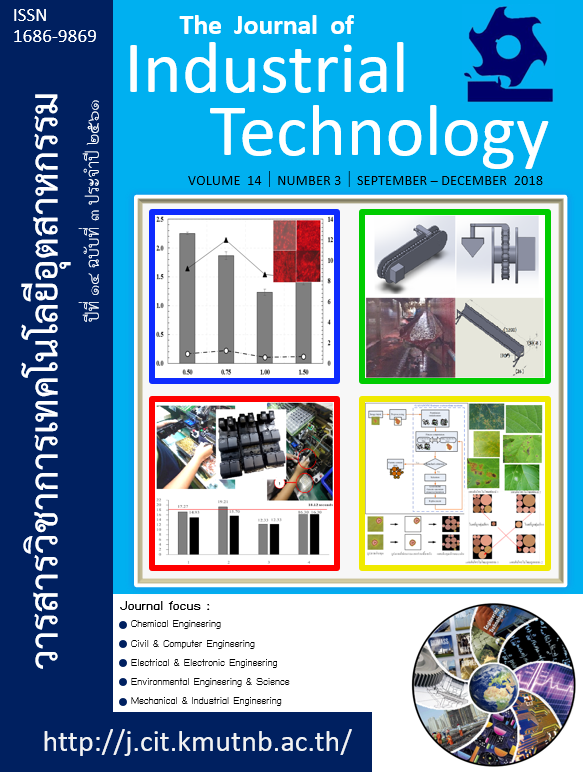(การปรับปรุงสายการผลิตชิ้นส่วนรถยนต์ด้วยเครื่องมือทางวิศวกรรมอุตสาหการ) (Improvement Production Line of Auto Part Using Industrial Engineering Tools)
Keywords:
ECRS principle, Line balancing, Work study, Industrial engineering toolsAbstract
In this research, we improved production line of auto parts: case study of main power A-Plat No. 1 line especially effected that back order as 16.50 percentages. The result of in case study was found that the mainly problems in this process were over process and endless process, our researches interested to elimination of wastes in the process. The firstly, the process study was improved by engineering tools such as work study and time study; it typically was analyzed by seven wastes in this process. The problems of process was analyzed by Fish bone diagram. The ECRS principle had improved in process efficiency and the result was found that the process time continuously reduced from 17.27 to 14.93 seconds per piece, percentage as 13.55% for station 1 and process time at station 2 reduced from 19.21 to 15.70 seconds per piece, percentage as 18.27%. The productivity of process increased from 187 to 220 pieces per hour and 84.73 to 90.89% for balancing process. The backorder had decreased from 16.50 to 13.22%.
References
[2] K. Worawonghiran, “Process Efficiency Improvement for Automotive Parts Production Line”, Master Thesis, Major of Logistics and Supply Chain Management, Burapha University, 2016. (in Thai)
[3] J. Hongsai, “Improving the Efficiency in Automotive Part Manufacturing Process of Door Assy Console Compartment”, Sripatum Chonburi Journal, 2014, pp. 133-137. (in Thai)
[4] K. Hemanand, D. Amutbuselvan, G. Sundararaja and S. Chidambara Raja, “Improving Productivity of Manufacturing Division using Lean Concepts and Development Gravity Feeder-A case study” International Journal of Lean Thinking 3(2), 2012, pp 117-134.
[5] R. Kamble and V. Kulkarni, “Productivity Improvement at Assembly Station using Work Study Techniques” International Journal of Research in Engineering and Technology 3, 2014, pp. 480-487.
[6] S. Saranpracha, “Capacity Improvement of Car-Seat Part Production Line with Toyota Production System Concept”, Master Thesis, Major of Industrial Engineering, Chulalongkorn University, 2014. (in Thai)
[7] P.A. Ozor, C.L. Orji-Oko and C.K. Olua, “Productivity Improvement of Small and Medium Scale Enterprises using Lean Concept: Case Study of a Bread Factory” European Journal of Business and Management 7, 2015, pp. 73-84.
[8] M. Usoh, “To reduce waste in the process of product assembly by balancing the production line”, Sau Journal of Science & Tecnology 1, 2015, pp. 50-57. (in Thai)
[9] S. Sininpan and N. Kuptasthien, “Wastes Reduction in Motorcycle Part Production Line Using Integrated IE Techniques” Major of Industrial Engineering, Rajamangala University of Technology Thanyaburi, 2011. (in Thai)
[10] C. Cheua, R. dankunthod and C. goiejorhor, “Increasing Production Efficiency for Rubber Edge Auto Body Process Nishikawa Techaplalers Rubber Company, Limited” Proceedings of the Conference on Industrial Engineering Network, 2011, pp. 254-263. (in Thai)
[11] M. Chueprasert and P. Ongkunaruk, “Productivity improvement based line balancing: a case study of pasteurized milk manufacturer” International Food Research Journal 22, 2015, pp. 2313-2317.
[12] C. Kasemset, C. Boonmee and P. Khuntaporn, “Application of MFCA and ECRS in Waste Reduction: A Case Study of Electronic Parts Factory” Proceedings of the 2016 International Conference on Industrial Engineering and Operations Management Kuala Lumpur, Malaysia, 2016.
[13] A. Kalar, S. Srivatava, S. Marwah and R. Bhatia, “Productivity Improvement in Assembly Line of Automobile Industry by Reduction Cycle time of Operations” International Journal of Engineering Research and Technology 5, 2016, pp.28-31.


